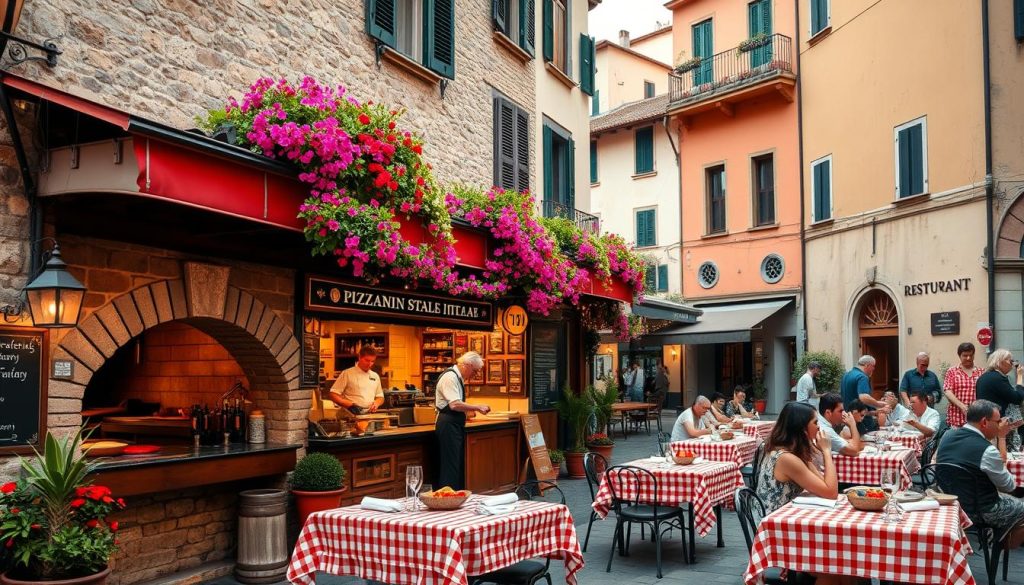Starting a restaurant in Italy is an exciting venture. It’s filled with the country’s rich culinary heritage. But, it needs careful planning and a grasp of the local market to succeed. Foreign entrepreneurs must be well-prepared to navigate Italy’s unique food culture.
New restaurant owners can stand out by using regional flavours and creating welcoming atmospheres. Italy’s dining scene is known for its food and specific operational details. These can greatly affect a restaurant’s success.
Key Takeaways
- Conduct thorough market research to understand the local food culture.
- Consider the costs associated with starting a business, from incorporation to licensing.
- Engage with the community to build relationships and garner support.
- Develop a unique menu that highlights traditional Italian recipes and local ingredients.
- Focus on creating an inviting restaurant atmosphere that reflects Italian hospitality.
- Utilise effective marketing strategies to attract customers to your new establishment.
Understanding the Italian Restaurant Market

The Italian restaurant market is full of different regional cuisines. It’s important to understand these trends well. Doing thorough market research is key for anyone starting a restaurant here.
Looking into the local demographic gives valuable insights. This includes knowing about age groups, income levels, and cultural diversity. This information helps tailor your restaurant concept well.
A crowded market can be a challenge, especially for new restaurants. There are many pizza places and pasta houses. It’s important to stand out and offer something unique.
Explaining what makes your restaurant special is crucial. This attracts customers looking for authentic experiences. By exploring Italy’s diverse cuisines, you can create a menu that showcases different flavours.
Using local ingredients can make simple dishes stand out. Seasonal menus encourage customers to come back. In today’s world, social media is key for marketing and keeping the community engaged.
Authenticity is the key to success. It builds a good reputation among those seeking real Italian tastes.
Accuracy in order processing and understanding customer preferences are vital. Following health and safety standards is also important. Working with local suppliers and influencers can boost your brand and loyalty.
Exploring these opportunities can help your restaurant stand out in the competitive Italian dining scene.
Tips for Opening a Restaurant in Italy
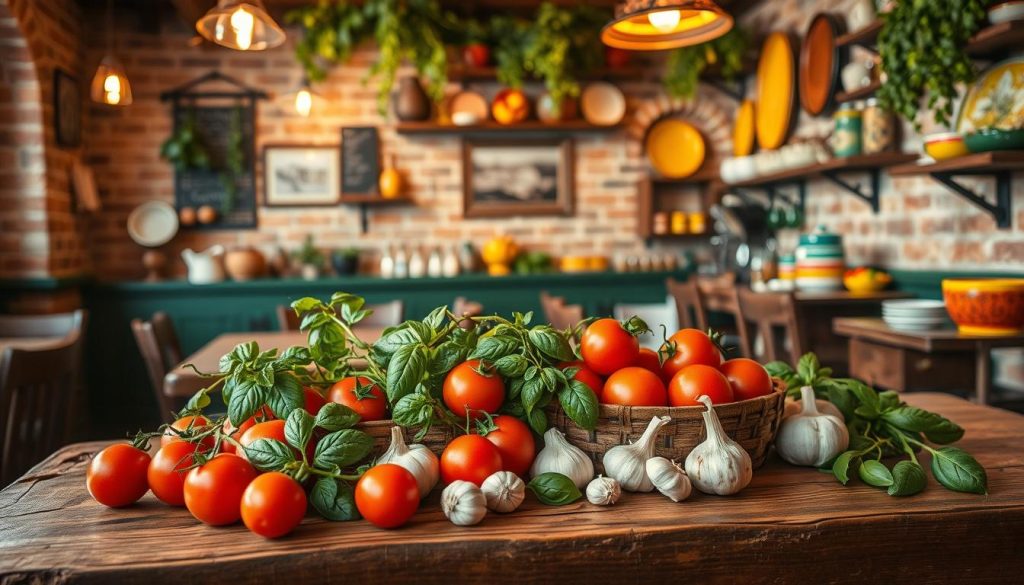
Opening a restaurant in Italy means understanding the local culture. This culture blends tradition with modern tastes. Working with local chefs can offer valuable insights. Remember, Italians love warm hospitality in their dining experiences.
Knowing the typical dining times in Italy is key. People usually eat dinner between 8pm and 9pm. In summer, especially in the south, dinner can go up to 10pm. Lunch is from 12pm to 1pm, and dinner starts at 7.30pm or 8pm. Pizzerias might open earlier, around 7pm.
It’s important to have a menu that follows the traditional Italian structure. Menus are divided into courses: antipasti, primi, secondi, contorni, dolci, and caffè. Antipasti include dishes like bruschetta or grilled vegetables. Primis are pasta or risotto dishes. Secondis are main courses of meat or fish, and contornis are side dishes.
Building good relationships with local suppliers is crucial. It ensures you get high-quality ingredients and authentic dishes. Working with regional producers can make your restaurant stand out.
Knowing the local dining trends is important. Reservations are common between 8 and 10 p.m. High-end places might need bookings months ahead. Also, using the 24-hour clock for bookings helps communicate better with locals.
Finally, it’s important to be aware of the risks. About 90% of new restaurants fail. So, careful planning, managing risks, and getting the right licenses are crucial. By understanding Italian culture and following local dining practices, you can build a successful restaurant.
Choosing the Right Location for Your Restaurant
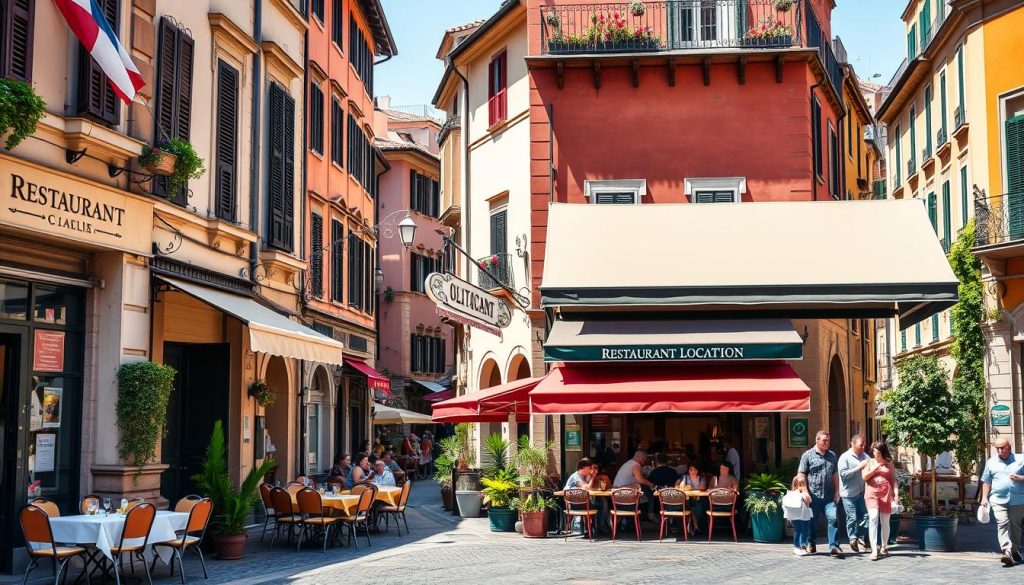
The location of your restaurant is key to its success. It’s important to research well when setting up in Italy. Areas with lots of tourists can draw in customers, but knowing what locals want is also crucial for growth. Think about how visible, easy to get to, and close to rivals your spot should be.
Getting to your restaurant easily is important for attracting customers. Choosing a spot that’s convenient for people is vital in Italy’s fast-paced food scene. Also, look at the local demographics to make sure your menu and atmosphere fit what people want.
Here are some tips for picking the right spot:
- Work with local property agents to find out about different areas and up-and-coming spots.
- Watch how much people spend to adjust your location strategy based on demand and the economy.
- Team up with local business groups to learn about the economic health and support in various places.
- Do a competitor analysis to stand out and offer something unique that locals will love.
- Make sure the location can handle technical needs like enough power for kitchen gear and free Wi-Fi for a better customer experience.
By considering these points, you can make a stronger choice for your restaurant’s location in Italy. This will help your new venture thrive.
Legal Considerations for Foreign Entrepreneurs
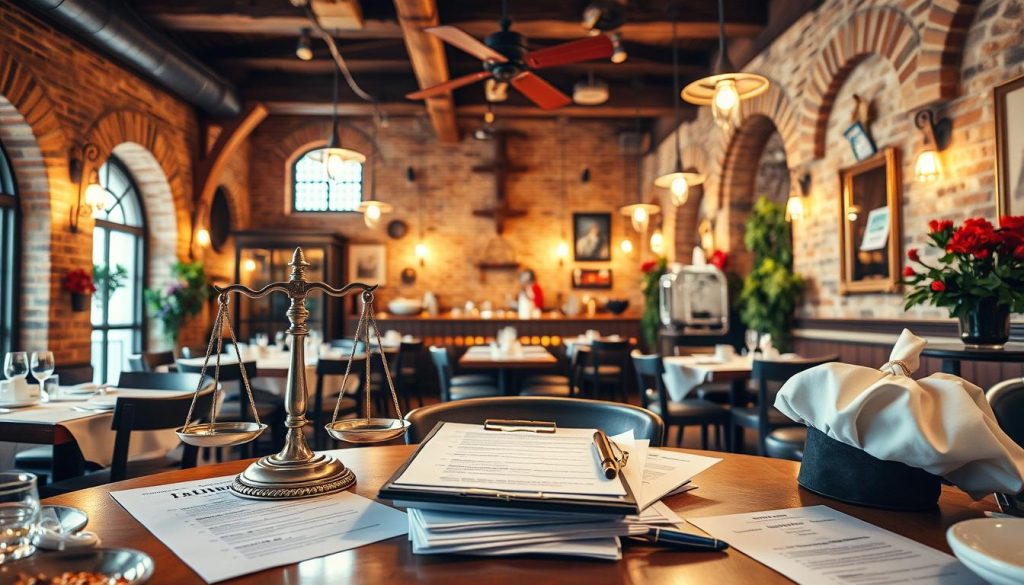
Starting a restaurant in Italy is a big task for foreign entrepreneurs. You need to get the right permits and follow local laws. The SCIA (Segnalazione Certificata di Inizio Attività) is a key permit to start your business. Knowing the laws well is key to a successful restaurant.
Essential Permits and Licences Needed
There are many permits and licences for a restaurant in Italy. Here are some important ones:
- SCIA: Needed to tell authorities you’re starting your business.
- Health and safety documents: These ensure your restaurant is clean and safe.
- Licences for food and drinks: You need specific permits based on your restaurant type.
Foreign entrepreneurs also need a Codice Fiscale (tax ID) and, if needed, migration and residence permits. This is especially true for non-EU citizens. Knowing all about permits is key to following the law.
Understanding Business Structures in Italy
Choosing the right business structure in Italy is important for investors. You can choose from:
- Sole Proprietorship: You’re personally responsible for debts.
- Limited Liability Company (LLC): Protects your personal assets from business debts.
- Partnerships: Two or more people share profits and duties.
In Italy, most businesses are small, with 93.3% having fewer than 10 employees. This is good news for foreign entrepreneurs wanting to start small in the restaurant sector. It’s important to pick the right structure for your business.
Developing a Robust Business Plan
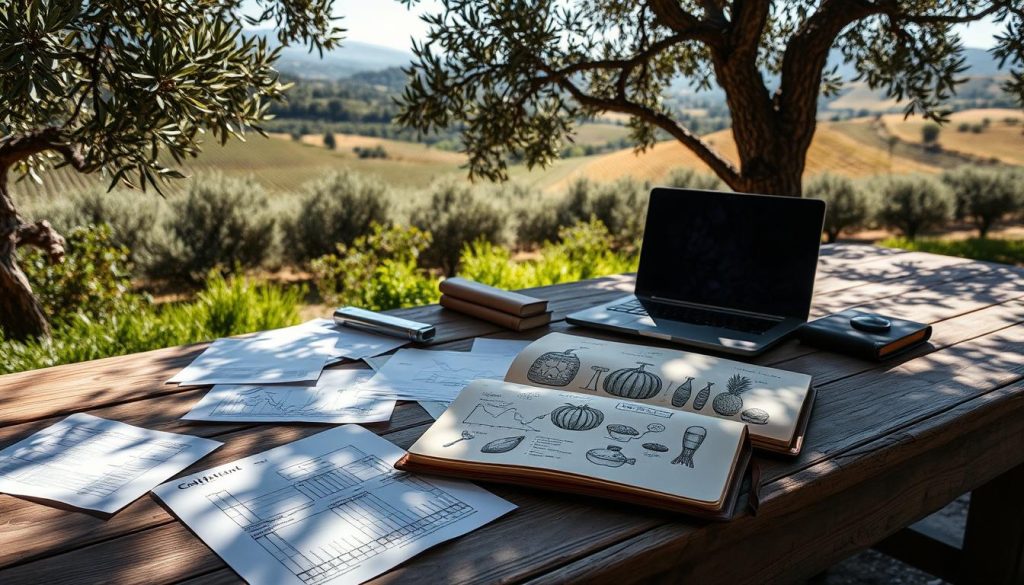
A solid business plan is like a roadmap for your restaurant’s success. It includes key parts like concept development, market analysis, marketing strategy, and financial forecasts. In 2024, making a business plan in Italy is key to staying competitive.
Market research helps you understand your audience and rivals. This guides your choices on what to offer and how much to charge. A good plan also shows how much money you need, like BellaTavola Ristorante aiming for $5 million in five years.
When planning finances for restaurants, you need to look at revenues, startup costs, and expenses. This helps with budgeting and managing costs. Italy’s restaurant industry has grown 2.5% historically, so you must plan for challenges with creative solutions.
Adding things like menus and interior designs to your plan can help. They support your project and make it clear to investors.
Choosing the right legal structure is also important. It affects your protection, growth, and tax situation in Italy. With 60% of new places failing in their first year, a detailed plan is crucial for success.
Spending about 30% of your budget on marketing can really help. It boosts customer numbers and keeps them coming back, leading to long-term success.
Navigating the Costs of Starting a Restaurant
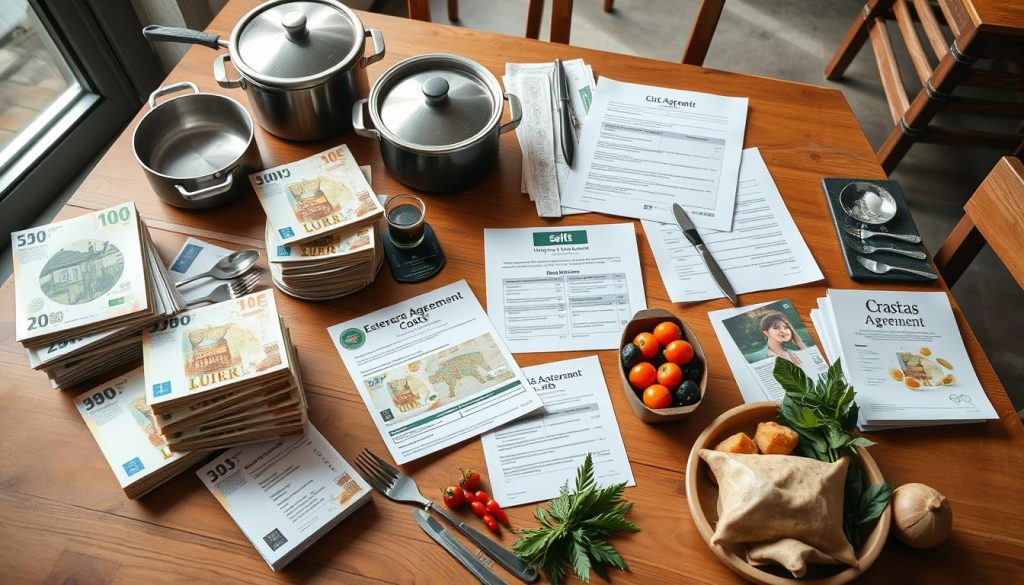
Starting a restaurant in Italy comes with its own set of financial hurdles. It’s vital to grasp the costs involved to ensure success. Initial costs can vary from $175,500 to over $2 million, influenced by location, renovation, and licensing. For Italian restaurants, initial investments include incorporation fees, equipment, and décor.
Initial Startup Costs Explained
The costs to start a restaurant are high, often around €5,650 in the first year for registration and incorporation. Other startup expenses include:
- Renovation costs ranging from €5,000 to over €50,000, depending on the desired aesthetic.
- Kitchen and bar equipment averaging around €115,655.
- Licensing fees that can vary greatly, with liquor licenses costing between €300 and €14,000 depending on local regulations.
- Miscellaneous charges, including unexpected costs for construction mishaps.
- Administrative expenses for forming a business entity, which can totals from €950 to €5,350.
These costs need careful planning and allocation in your financial strategy.
Understanding Ongoing Operating Expenses
Managing ongoing expenses is just as crucial. These include rent, utilities, and staff salaries. For example, the average rent for a restaurant is around €5,000 a month. Utilities account for 3% to 5% of total costs, while labour costs should be around 25% to 30%.
Food costs, about 28% to 35% of ongoing expenses, need constant monitoring. Creative budgeting can help, like negotiating with vendors, a strategy used by 40% of owners. Managers must also watch seasonal ingredient prices and technology expenses to optimise profits. Understanding these details is key to navigating the restaurant’s financial landscape.
Obtaining the Necessary Licences and Permits
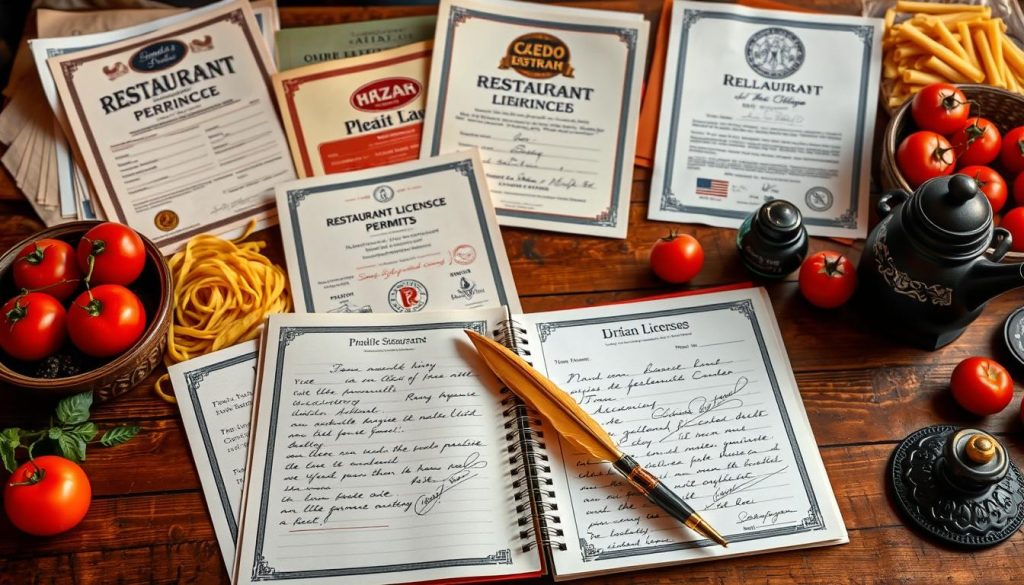
Getting the right licences for restaurants in Italy is crucial. Each place needs health permits, business licences, and liquor licenses if needed. About 95% of new places must get a health permit from their local health department. This is key for keeping everyone safe.
Not passing health checks can lead to big fines or even closing down. This affects almost 80% of restaurants.
To get permits in Italy, you must know the local rules and talk to regional authorities. Food handling and safety permits are needed for about 75% of staff. Owners and managers, making up about 90% of staff, usually need these permits.
Building licences are also needed for safety standards. This ensures places follow local codes 100% of the time. Signage and music licences are also important, affecting 85% and 98% of places, respectively. About 70% of places need local zoning permits and certificates of occupancy.
It’s important to keep and renew licences to stay legal. With 85% of restaurants needing new or updated licences, being proactive is essential. This helps avoid fines for not having the right papers, affecting almost 99% of places.
Creating an Authentic Italian Menu
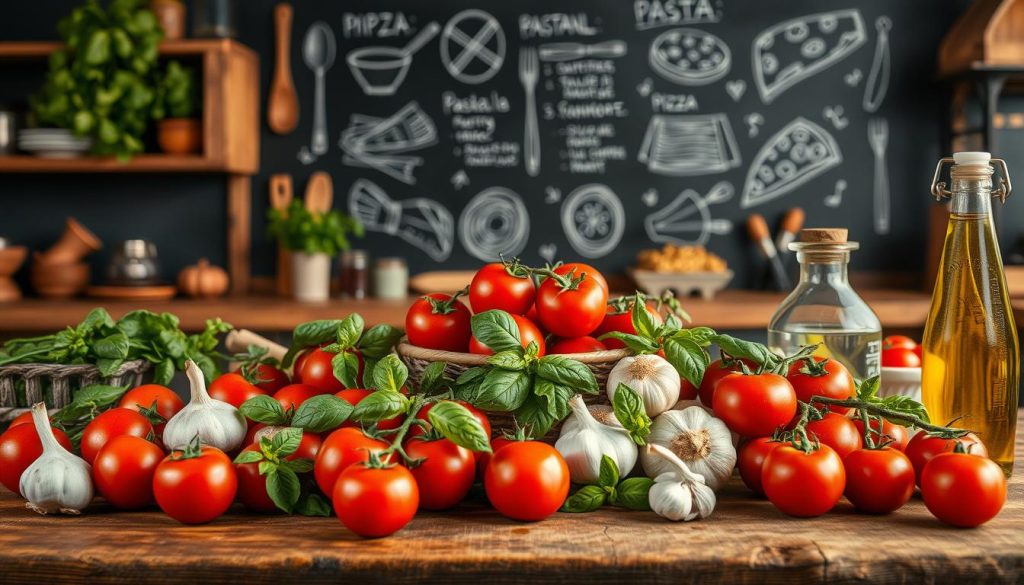
An authentic Italian menu is the heart of your restaurant. It shows the rich traditions and flavours of Italian cuisine. It’s all about using regional recipes, local ingredients, and making each dish special. This way, you offer a unique dining experience that celebrates Italy’s culture and heritage.
Incorporating Traditional Recipes and Flavours
To make a great menu, you need to use traditional recipes. These recipes show the variety of Italian cooking. A traditional Italian meal has three parts: antipasti, primi, and secondi, with dolce (dessert) as an option.
Antipasti are small dishes that start the meal. They vary a lot from one region to another. Primi are mostly pasta dishes, but in the north, risotto is more common. Secondi include a range of dishes, from fish to meat and chicken, offering something for everyone.
Salads are often served before the main course to help with digestion. They’re dressed with olive oil and balsamic vinegar. Adding these traditional touches brings the real Italian dining experience to your guests.
Utilising Local Ingredients for Freshness
Using local ingredients is key to a genuine Italian menu. Italian food is all about fresh, local produce for the best taste. Dishes should use ingredients that are in season, working with local farmers and suppliers for freshness. Bread is a big part of meals, often served at the table with sauces. Traditional breakfasts are light, with pastries and dark coffee.
Desserts like gelato, tiramisu, and torte end meals nicely, adding to the authentic Italian experience.
Understanding Italian Food Regulations
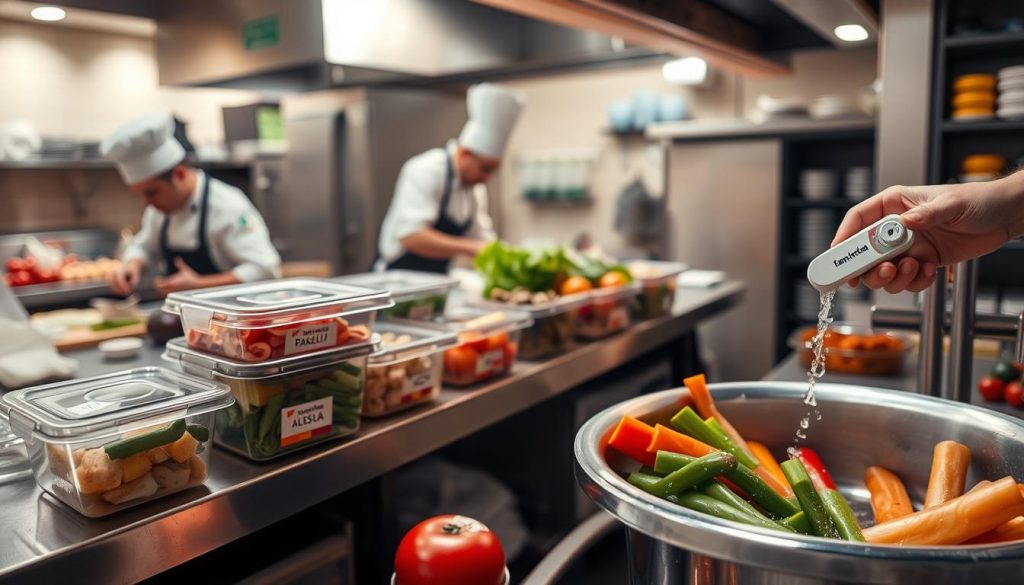
In Italy, food safety rules are very strict. They aim to ensure top quality and safety in food. Restaurant owners must follow strict hygiene and food safety rules. Regular checks are key to keeping kitchens clean and safe.
It’s important for owners to know about the needed documents, labelling rules, and local health laws. This helps keep their restaurant’s good name.
Italian food culture loves organic and clear labels, matching the strict rules. Shops and buildings often close for a couple of hours for lunch. This allows for a set meal time, starting with antipasto, then pasta, and ending with dessert and coffee.
This structured meal time helps keep food safety rules in Italy. It makes sure customers are happy and follow local rules.
It’s common for diners to take leftovers home, showing a cultural norm. Restaurant managers need to know about these rules. They should use top-quality ingredients, like Gentile and Martelli pasta.
Understanding local tastes is key to success. It helps meet food safety rules in Italy and gives great dining experiences.
Restaurant owners must keep learning about new rules and standards. This helps avoid legal problems and protects their business. Mixing old cooking ways with new ones can improve both compliance and food quality.
Keeping up with food safety rules in Italy is crucial. It helps restaurants stay compliant and shows their dedication to quality. This leads to happy customers and a great dining experience.
Design and Ambience of Your Restaurant
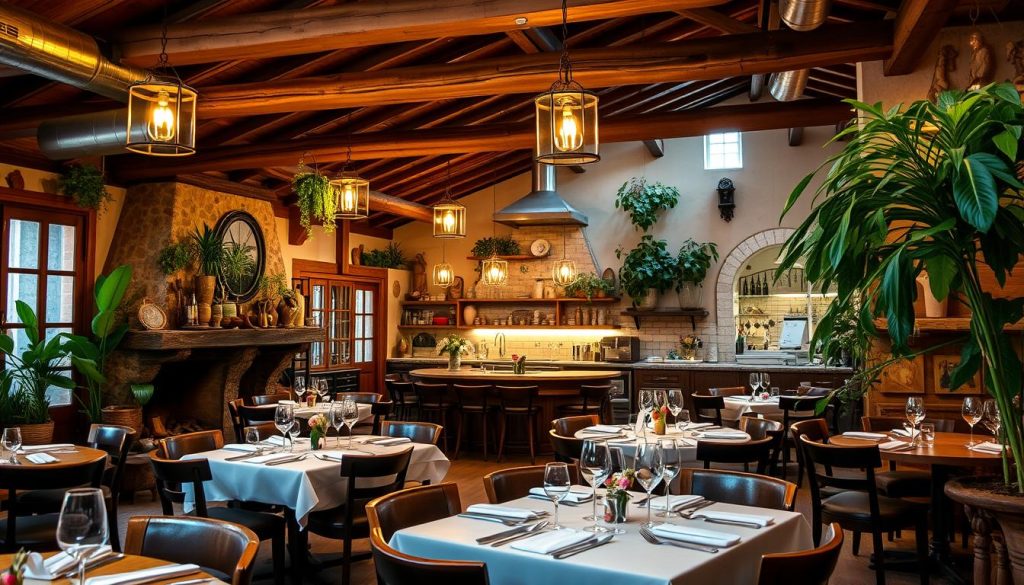
The design and ambience of your restaurant greatly affect the customer experience. It’s key to create a welcoming atmosphere that shows off authentic Italian style. Traditional Italian restaurants use earthy tones like terracotta and olive green to bring to mind Italian landscapes.
Adding natural textures like stone floors and wooden furniture makes dining better.
Good restaurant design looks great and helps things run smoothly. The way you set up seating and the kitchen layout can make service faster. This leads to happier customers and better table management.
Using sturdy wooden tables and comfy chairs is a must. Statement chandeliers add a touch of elegance.
For a classic look, add Italian murals and vintage furniture. Family photos can make the space feel more personal. Modern Italian places can use sleek metal and bold colours to draw in different people.
Lighting is key for a good atmosphere. Warm, soft lights make the place inviting and highlight the interior. Vintage lighting adds to the restaurant’s charm.
Playing Italian music adds to the dining experience. Outdoor seating can make the atmosphere even better. Use wooden furniture, umbrellas, and greenery for a peaceful feel.
Recruiting the Right Staff for Your Restaurant
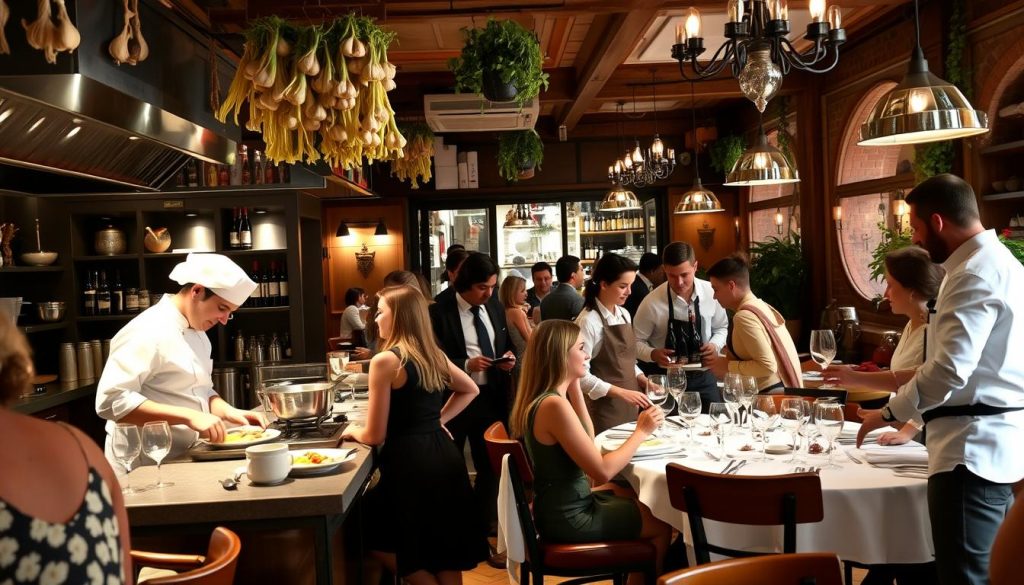
Getting the right staff is key for an Italian restaurant’s success. The industry sees a lot of staff changes, with many places replacing up to 75% of their team each year. Good staffing strategies can help reduce these issues and make things run smoother.
Importance of Training and Development
Training staff well is crucial for keeping service quality high. Labour costs are about 31.6% of expenses, so investing in staff can boost morale and productivity. This leads to happier customers.
Starting new staff off right is important. It sets them up for success in their roles.
Creating a Positive Work Environment
Building a good workplace culture is key to keeping staff happy and loyal. Clear rules and guidance help teams work better together. Rewarding good work keeps staff motivated.
Look for candidates who are polite, team players, and can handle stress well. A fair schedule and work-life balance help build a dedicated team.
Marketing Strategies for Your New Restaurant
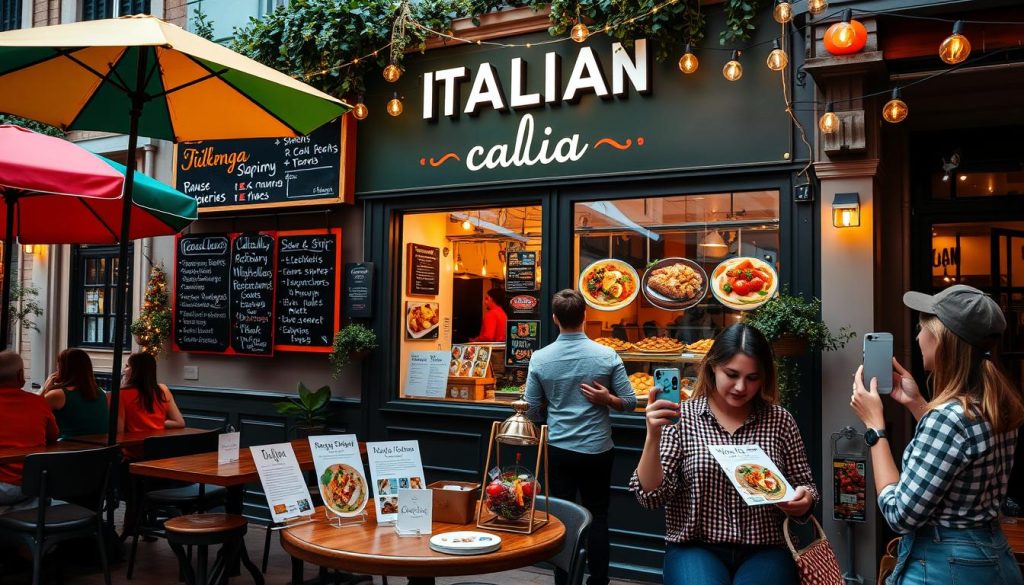
Getting people to come to your restaurant is key. Using social media to share daily specials can really help. Also, posting tasty food pictures can draw in customers. Happy diners sharing their meals online can also help attract more people.
Building a strong online community can make customers loyal. This can also make your restaurant’s brand stronger.
Utilising Social Media Platforms Effectively
Being on Google My Business and using the right keywords can boost your online presence. Loyalty programmes with points can encourage people to come back more often. In fact, 41% of people say these programmes make them want to buy more.
Text messages can also be a great way to reach out to customers. Since 93% of shoppers are okay with texts from brands, it’s a good strategy.
Hosting events like wine tastings can make your restaurant memorable. It also gives you content for social media. Using design platforms for your marketing materials can keep everything looking good. New ideas like augmented reality menus or storytelling apps can make dining even better.
Financial Management for Restaurant Success
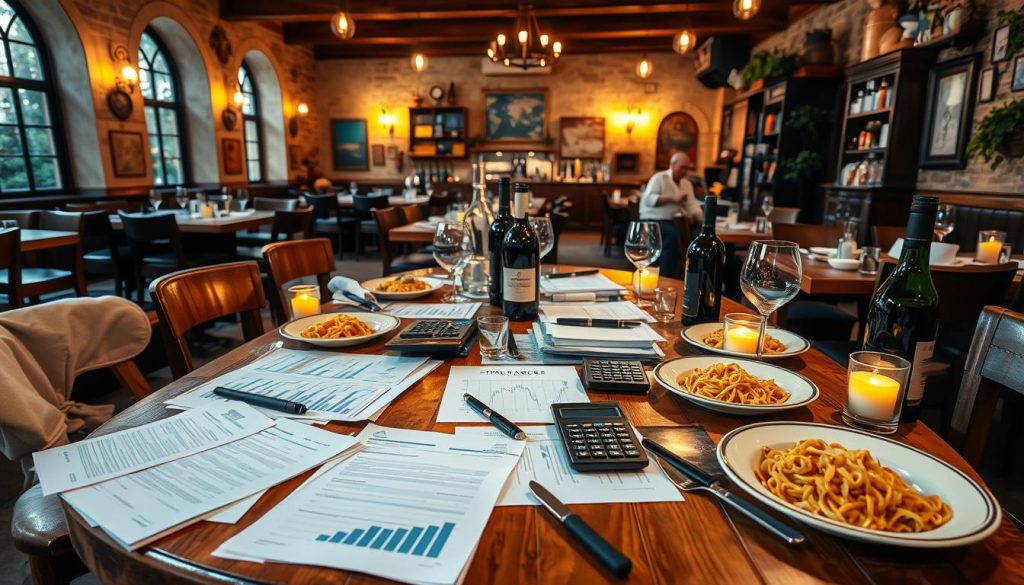
Effective financial management is key to a restaurant’s success. It involves monitoring cash flow and using reporting tools. These help ensure enough money for daily needs and future growth.
Negotiating with suppliers and buying in bulk can cut costs. Tracking food and labour costs is also crucial. It helps keep expenses under control.
Knowing how much each customer spends is important. It helps understand customer habits. The Italian restaurant industry in the US has over 40,000 places, making about $47 billion a year.
BellaTavola Ristorante aims to make $3,709,967 in its first year and $5,100,484 by the fifth. It’s vital to keep financial practices in check to meet these goals.
Starting a business often needs a lot of money for investments and running costs. BellaTavola Ristorante needs $251,000. Good budgeting and forecasting are essential for reaching financial targets.
Enhancing Customer Experience and Satisfaction
Creating memorable dining experiences is key to building a loyal customer base. This means offering attentive service, a welcoming atmosphere, and top-notch food. With over 80% of people willing to pay more for a great experience, restaurants that focus on service can boost repeat visits and success.
The feel of a restaurant, including lighting, decor, and seating, greatly affects guest happiness. Also, keeping food quality high is vital for keeping customers coming back. They like to return to places known for tasty, fresh meals. Using technology, like online booking and easy-to-use point-of-sale systems, also improves efficiency and customer happiness.
Listening to customer feedback is crucial for making improvements and creating a better dining experience. Personal touches, like special services for regulars, and ongoing staff training help ensure great service every time. This builds loyalty and boosts satisfaction in dining.

